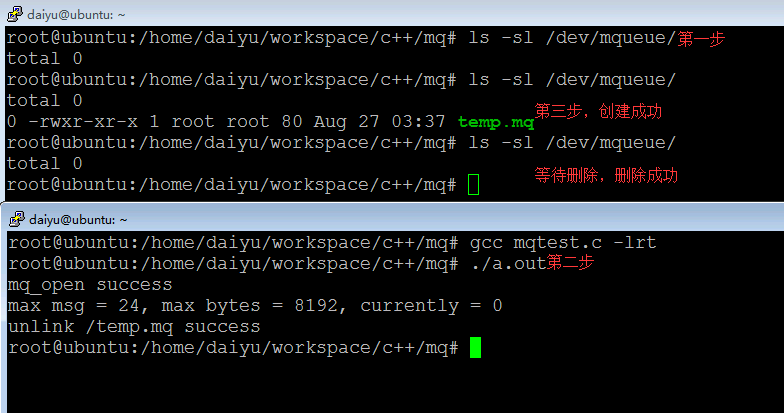基本概念:
消息队列可认为是一个消息链表。有足够写权限的线程可往队列中放置消息,有足够读权限的线程可从队列中取走消息,每个消息都是一个记录(非字节流式,也就是不需要自定义边界),它由发送者赋予一个优先级。在某个进程往一个队列写入消息之前,并不需要另外某个进程在该队列上等待消息的到达。
一个进程可以往某个队列写入一些消息,然后终止,再让另外一个进程在以后某个时刻读出这些消息。消息队列具有随内核的持续性,也就是进程关闭后,消息队列依然存在。
消息队列的标准:
消息队列分为两大标准,Posix消息队列和System V消息队列,此文只讲Posix消息队列。
此文的环境:
例子的运行系统:Ubuntu 14
运行前需要执行的命令(为什么需要执行下列命令,请查阅man 7 mq_overview):
Mounting the message queue filesystem
On Linux, message queues are created in a virtual filesystem. (Other
implementations may also provide such a feature, but the details are
likely to differ.) This filesystem can be mounted (by the superuser)
using the following commands:
# mkdir /dev/mqueue
# mount -t mqueue none /dev/mqueue
The sticky bit is automatically enabled on the mount directory.创建消息队列:
MQ_OPEN(3) Linux Programmer's Manual MQ_OPEN(3)
NAME
mq_open - open a message queue
SYNOPSIS
#include <fcntl.h> /* For O_* constants */
#include <sys/stat.h> /* For mode constants */
#include <mqueue.h>
mqd_t mq_open(const char *name, int oflag);
mqd_t mq_open(const char *name, int oflag, mode_t mode,
struct mq_attr *attr);
Link with -lrt.
关闭消息队列:
MQ_CLOSE(3) Linux Programmer's Manual MQ_CLOSE(3)
NAME
mq_close - close a message queue descriptor
SYNOPSIS
#include <mqueue.h>
int mq_close(mqd_t mqdes);
Link with -lrt.删除消息队列:
MQ_UNLINK(3) Linux Programmer's Manual MQ_UNLINK(3)
NAME
mq_unlink - remove a message queue
SYNOPSIS
#include <mqueue.h>
int mq_unlink(const char *name);
Link with -lrt.
获取/设置消息队列属性:
MQ_GETATTR(3) Linux Programmer's Manual MQ_GETATTR(3)
NAME
mq_getattr, mq_setattr - get/set message queue attributes
SYNOPSIS
#include <mqueue.h>
int mq_getattr(mqd_t mqdes, struct mq_attr *attr);
int mq_setattr(mqd_t mqdes, struct mq_attr *newattr,
struct mq_attr *oldattr);
Link with -lrt.
mq_attr结构含有以下属性
struct mq_attr {
long mq_flags; /* Flags: 0 or O_NONBLOCK */
long mq_maxmsg; /* Max. # of messages on queue */
long mq_msgsize; /* Max. message size (bytes) */
long mq_curmsgs; /* # of messages currently in queue */
};a)mq_setattr函数只允许设置mq_attr结构的mq_flags成员,其它三个成员被忽略。
c)消息队列中的当前消息数则只能获取不能设置。
例子1,创建并设置消息队列的属性,再删除消息队列。
#include <fcntl.h>
#include <sys/stat.h>
#include <mqueue.h>
#include <stdio.h>
#include <errno.h>
#include <stdlib.h>
#include <string.h>
int main()
{
struct mq_attr attr;
attr.mq_maxmsg = 24; /* 设置消息队列的最大消息个数 */
attr.mq_msgsize = 8192; /* 设置每个消息的最大字节数 */
char *name = "/temp.mq"; /* linux必须是/filename这种格式,不能出现二级目录 */
mqd_t mqd = mq_open(name, O_RDWR | O_CREAT | O_EXCL, 0777, &attr);
if (mqd == -1) {
perror("create failed");
mqd = mq_open(name, O_RDWR);
if (mqd == -1) {
perror("open failed");
exit(EXIT_FAILURE);
}
}
printf("mq_open %s success\n", name);
/* 打开成功,获取当前属性 */
mq_getattr(mqd, &attr);
printf("max msg = %ld, max bytes = %ld, currently = %ld\n",
attr.mq_maxmsg, attr.mq_msgsize, attr.mq_curmsgs);
/* 关闭 */
if (mq_close(mqd) != -1)
printf("mq_close %s success\n", name);
/* 删除 */
sleep(30); /* 观察创建情况 */
if (mq_unlink(name) != -1)
printf("mq_unlink %s success\n", name);
return 0;
}
编译运行:
发送消息:
MQ_SEND(3) Linux Programmer's Manual MQ_SEND(3)
NAME
mq_send, mq_timedsend - send a message to a message queue
SYNOPSIS
#include <mqueue.h>
int mq_send(mqd_t mqdes, const char *msg_ptr,
size_t msg_len, unsigned msg_prio);
#include <time.h>
#include <mqueue.h>
int mq_timedsend(mqd_t mqdes, const char *msg_ptr,
size_t msg_len, unsigned msg_prio,
const struct timespec *abs_timeout);
Link with -lrt.mq_send的prio参数是待发送消息的优先级,其值必须小于MQ_PRIO_MAX。如果应用不必使用优先级不同的消息,那就给mq_send指定值为0的优先级,给mq_reveive指定一个空指针作为其最后一个参数。
接收消息:
MQ_RECEIVE(3) Linux Programmer's Manual MQ_RECEIVE(3)
NAME
mq_receive, mq_timedreceive - receive a message from a message queue
SYNOPSIS
#include <mqueue.h>
ssize_t mq_receive(mqd_t mqdes, char *msg_ptr,
size_t msg_len, unsigned *msg_prio);
#include <time.h>
#include <mqueue.h>
ssize_t mq_timedreceive(mqd_t mqdes, char *msg_ptr,
size_t msg_len, unsigned *msg_prio,
const struct timespec *abs_timeout);
Link with -lrt.
mq_receive总是返回所指定队列中最高优先级的最早消息,而且该优先级能随该消息的内容及其长度一同返回。
mq_receive的len参数的值不能小于能加到所指定队里中的消息的最大大小(该队列mq_attr结构的mq_msgsize成员)。要是len小于该值,mq_reveive就立即返回EMSGSIZE错误。这意味着使用Posix消息队列的大多数应用程序必须在打开某个队列后调用mq_getattr确定最大消息大小,然后分配一个或多个那样大小的读缓冲区。
例子2,发送3个优先级不同的消息并接收。
发送程序mqsend.c:
#include <fcntl.h>
#include <sys/stat.h>
#include <mqueue.h>
#include <stdio.h>
#include <errno.h>
#include <stdlib.h>
#include <string.h>
int main()
{
struct mq_attr attr;
attr.mq_maxmsg = 24; /* 设置消息队列的最大消息个数 */
attr.mq_msgsize = 8192; /* 设置每个消息的最大字节数 */
char *name = "/temp.mq"; /* linux必须是/filename这种格式,不能出现二级目录 */
mqd_t mqd = mq_open(name, O_RDWR | O_CREAT | O_EXCL, 0777, &attr);
if (mqd == -1) {
perror("create failed");
mqd = mq_open(name, O_RDWR);
if (mqd == -1) {
perror("open failed");
exit(EXIT_FAILURE);
}
}
printf("mq_open %s success\n", name);
/* 打开成功,获取当前属性 */
mq_getattr(mqd, &attr);
printf("max msg = %ld, max bytes = %ld, currently = %ld\n",
attr.mq_maxmsg, attr.mq_msgsize, attr.mq_curmsgs);
char *msg_ptr1 = "hello world1";
char *msg_ptr2 = "hello world2";
char *msg_ptr3 = "hello world3";
size_t msg_len1 = strlen(msg_ptr1);
size_t msg_len2 = strlen(msg_ptr2);
size_t msg_len3 = strlen(msg_ptr3);
/* 先发送优先级低的 */
mq_send(mqd, msg_ptr1, msg_len1, 1);
mq_send(mqd, msg_ptr2, msg_len2, 2);
mq_send(mqd, msg_ptr3, msg_len3, 3);
printf("mq_send success\n");
if (mq_close(mqd) != -1)
printf("mq_close %s success\n", name);
return 0;
}
接收程序mqreceive.c:
#include <fcntl.h>
#include <sys/stat.h>
#include <mqueue.h>
#include <stdio.h>
#include <errno.h>
#include <stdlib.h>
#include <string.h>
int main()
{
char *name = "/temp.mq"; /* linux必须是/filename这种格式,不能出现二级目录 */
mqd_t mqd = mq_open(name, O_RDWR);
if (mqd == -1) {
perror("open failed");
exit(EXIT_FAILURE);
}
printf("mq_open %s success\n", name);
struct mq_attr attr;
if (mq_getattr(mqd, &attr) == -1) {
perror("mq_getattr failed");
exit(EXIT_FAILURE);
}
char *msg_ptr;
size_t msg_len = attr.mq_msgsize;
unsigned msg_prio;
msg_ptr = (char *)malloc(msg_len);
while (1) {
bzero(msg_ptr, msg_len);
int res = mq_receive(mqd, msg_ptr, msg_len, &msg_prio);
if (res != -1) {
printf("msg is:%s, msg_prio:%d\n", msg_ptr, msg_prio);
} else {
perror("mq_receive failed");
break;
}
}
if (mq_close(mqd) != -1)
printf("mq_close %s success\n", name);
return 0;
}
编译运行:
消息队列限制:
我们已经遇到任意给定队列的两个限制,它们都是在创建该队列时建立的(测试中发现mq_getattr与ulimit -q的结果并不一致):
mq_maxmsg ->队列中的最大消息数
mq_msgsize ->给定消息的最大字节数
消息队列的实现定义了另外两个限制(调用sysconf函数获取):
MQ_OPEN_MAX -> 一个进程能够同时拥有的打开着消息队列的最大数目
MQ_PRIO_MAX -> 任意消息的最大优先级加1
测试代码与运行结果:
#include <unistd.h>
#include <stdio.h>
// man 7 mq_overview
int main()
{
long mq_open_max = sysconf(_SC_MQ_OPEN_MAX);
long mq_prio_max = sysconf(_SC_MQ_PRIO_MAX);
printf("mq_open_max:%ld\n", mq_open_max);
printf("mq_prio_max:%ld\n", mq_prio_max);
}
高级:
Posix消息队列允许异步事件通知,以告知合适有一个消息放置到某个空消息队列中。这种通知有两种方式可供选择:
a)产生一个信号
b)创建一个线程来执行一个指定的函数。
这种通知通过调用mq_notify建立。
MQ_NOTIFY(3) Linux Programmer's Manual MQ_NOTIFY(3)
NAME
mq_notify - register for notification when a message is available
SYNOPSIS
#include <mqueue.h>
int mq_notify(mqd_t mqdes, const struct sigevent *sevp);
Link with -lrt.
这里不进行深入展开。
参考:《unix网络编程》·卷2
End;
























 4593
4593











 被折叠的 条评论
为什么被折叠?
被折叠的 条评论
为什么被折叠?








